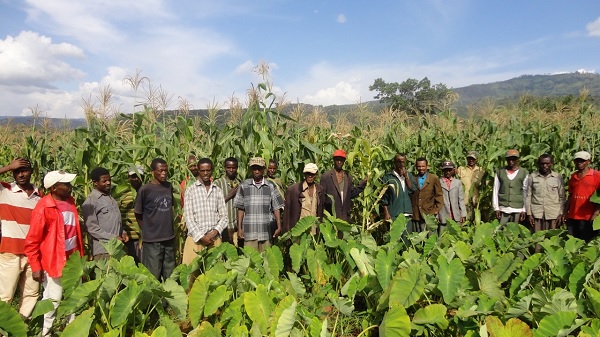
The Terepeza Development Agency (TDA) is the community development arm of Ethiopia’s Wolayta Kale Heywot Church. We serve the Southern region of the country with over 200 staff and several thousand community volunteers.
(Canadian Foodgrains Bank)–In the Kindo Koysha District of Ethiopia (Wolayita Zone), staff at the Terepeza Development Association (TDA) are busy sharing the news of conservation agriculture.
The TDA, which is supported by Canadian Foodgrains Bank through its member Tearfund Canada, is sending out its staff—they call them “animators”—and training families and communities in a different way of farming in the dry and hilly area about 360 kilometers southwest of the capital of Addis Ababa.
“Where you have lots of soil erosion, conservation agriculture is the only way,” says Bereket Tassew, director of TDA.
“Where the land is deteriorated, it is the only way to grow good crops.”
The TDA project is one of 11 across Ethiopia, Kenya and Tanzania, which together, make up the Scaling-Up Conservation Agriculture in East Africa program of the Foodgrains Bank and its members Mennonite Central Committee Canada, Tearfund Canada (previously World Relief Canada) and World Renew.
Through the five-year, $18.6 million program made possible by a $14 million grant from the Government of Canada, farm families who struggle to grow enough to support themselves are being trained in conservation agriculture methods to increase the fertility of their soil and improve their yields.
For farm families in these countries, a poor crop year can have devastating consequences.
“It might mean getting by on only one or two meals a day until a new harvest can be brought in,” says Theresa Rempel-Mulaire, who manages the program. “It could mean children being pulled from school if their parents can no longer afford fees, for example, or other difficult financial choices.”
Five-year program midway through
The program, which runs from 2015 to 2020, has just passed the halfway point. The goal is to have 50,000 farmers practicing conservation agriculture after five years. By the end of 2017, they passed the 21,000 mark and the program is moving quickly toward its target.
For Rempel Mulaire and the members of her team, one of the highlights so far has been watching farmers discover just how productive their small plots can be when properly managed.
“I meet so many small-scale farmers who used to be discouraged by the poor state of their land and their inability to provide for their families from it,” she says. “It’s amazing to see the transformation that occurs when a farmer sees just how healthy and productive their land can be with good management.”
One of those farmers is Tesfaye Bukulo, a participant in the TDA project.
In 2015, the father of five decided to give conservation agriculture a try. After receiving training and planting his first conservation agriculture crop, he saw positive results: Where he once got almost no crops, because of the drought, he grew over 200 kilograms of maize.
“It also reduced erosion during rain and due to wind,” he says. “The soil is much better now.”
It’s also less work. Since the mulch cover inhibits weeds, his family doesn’t have to do as much weeding—something that makes his children happy.
And since he doesn’t plow his field, he doesn’t need to ask neighbors to come and help, as he has traditionally done—which makes his wife, Mogise, happy since she doesn’t have to prepare food for field days anymore.
There were critics, he says—non-believers who said it wouldn’t work.
“There were some who tried to discourage me,” says Tesfaye. “But when they saw the results, they were convinced.”
Such results are closely monitored.
For example, one project in Ethiopia, through Mennonite Central Committee Canada, farmers practicing conservation agriculture yielded an average of 925 kilograms of fava beans per hectare, while those using conventional methods only yielded an average of 750 kilograms—a difference of almost 25%.
Sharing conservation agriculture with friends and neighbors
Now Tesfaye says he shares what he’s learned about conservation agriculture with other farmers; he’s become an advisor and coach to 20 of his neighbors.
This includes Tadimes Zemedkun, who has become what’s called a “copy farmer”—when he saw the results Tesfaye got, he decided to try it himself.
“I was convinced by what I saw from on his field,” says the father of six of his first attempt at conservation agriculture, noting that he’s expecting good results this season.
“Conservation agriculture is changing lives,” says Tassew. “Through it, farmers have hope. The drought conditions have been very bad recently, but through conservation agriculture they can still grow enough food for their families.”
To learn more about the Scaling-Up Conservation Agriculture in East Africa program or to donate, click here.
–Amanda Thorsteinsson, communications coordinator, with files from John Longhurst, director of resource and public engagement
Source: Canadian Foodgrains Bank
